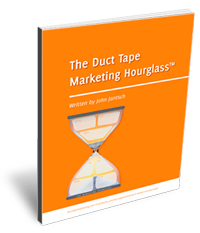The Marketing Hourglass - A Logical Path to Marketing Success
small business marketing, duct tape marketing, Marketing eBooks, online marketing
 The Marketing Hourglass is one of the core concepts of Duct Tape Marketing and was first introduced in our main eBook, The 7 Steps to Small Business Marketing Success.
The Marketing Hourglass is one of the core concepts of Duct Tape Marketing and was first introduced in our main eBook, The 7 Steps to Small Business Marketing Success.
While most of us are familiar with the marketing funnel (where you gather in a whole bunch of leads and then spit them out the bottom), the Marketing Hourglass builds on this concept in two key ways:
- The top part of the funnel is expanded to include the process of getting customers to Know - Like - Trust and Try your products or services. With the traditional funnel, the focus is on getting prospects to Know you and then trying to convert them directly to Buy. This is one of the main reasons many companies believe their advertising doesn't work.
- A bottom half is added to the funnel.With the Marketing Hourglass, the process doesn't stop once your prospect becomes a customer. Instead, equal emphasis is placed on finding ways to wow and leverage your customers after the sale through the phases of Buy - Repeat, and Refer.
A Logical Path to Marketing Success
What the Marketing Hourglass essentially does is gives us a series of logical steps for our prospects and customers to take along a path, instead of asking them to take giant leaps. These are steps small business owners can use to lay out their marketing system.
In a recent blog post, Follow the Logical Path to Marketing Success, Duct Tape Marketing founder John Jantsch outlined how this path might look for a typical B2B service business:
1. Know
The Know phase includes all of the typical lead generation activities that most of us associate with marketing. Advertising, public relations, direct marketing - and pretty much any other activity that will get prospects to be initially aware of you - will fall into this category.Know tacticscould include:
- A Google Ad promoting a free eBook that is related to your service offering but doesn’t sell anything directly
- A blog post answering some common client challenges amplified in social media
- Promoted posts on Facebook (yes - you can promote your individual posts now if you have more than 400 fans) marketing your free eBook
- Using LinkedIn answers to respond to key questions, and working in your blog posts and free eBook content.
2. Like
In the Like phase, the focus turns to your email capture activities, so you can essentially gain permission from your prospects to continue your conversation at some later date.Like tacticscould include:
- Creating landing pages for each of your distinct networks. On the landing page, have your prospects enter their email address in order to download your eBook. Then, set up an auto-responder email that delivers even more related information.
- Send a weekly newsletter to everyone who downloads your eBook.
3. Trust
While Trust may be the most important step in the hourglass, it's not one that is easily achieved through just one or two tactics - it comes over time as a result of a collection of activities.Trust tacticscould include:
- Consistently deliver a newsletter that contains educational - not promotional - information.
- Get backlinks from reputable websites
- Participate on Facebook, LinkedIn, Google + and Twitter by sharing information and helping others find information
- Consistently write educational blog content, stimulate reviews on sites like Google+, LinkedIn and Yelp
- Submit press releases to online distribution sites such as PRWeb and find industry or local publications that accept contributed content.
4. Try
Try is the step that is most often omitted by companies in the desire to leap ahead rather than lead.Try tacticscould include:
- Creating and delivering an online or in person seminar related to your eBook
- Creating a free or low cost experience of your knowledge or expertise through an audit or evaluation
- Create an unheard of guarantee, create a try before your buy option, create a low cost version or write a book.
5. Buy
This is the step we're all hoping to achieve - but don't stop here! This is just another stepping stone to the ultimate goal – a thoroughly thrilled customer.Buy tacticscould include:
- Wow your customer with more than you promised. For example, if you're a yoga studio, include a free mat with each lesson package.
- Create a new customer kit
6. Repeat
For most businesses, long-term momentum only occurs when the customers acquired in year one buy more as new customers are acquired in year two. This step should not fall into the hopeful category, but be an intentional step you've set in place right from the beginning.Repeat tacticsmight include:
- Create a results review process with every client
- Start an autorespoder series that provides education on additional solutions
- Check in on LinkedIn with clients occasionally just to say hi
- Systematically send press clippings
- Create custom RSS feeds
- Create a client only newsletter
7. Refer
Your goal should be 100% referral from your client base. While 100% may not ever happen, if you begin with this result in mind, it’s more likely.
Refer tactics could include:
- Create a partner team and introduce them to your clients
- Sponsor a not for profit event and include your clients
- Create eBooks or gift certificates that your clients can co-brand and distribute
- Feature your client stories in your marketing materials
- Hold client appreciation events
Source: John Jantsch: Follow the Logical Path to Marketing Success
Get started building your Marketing Hourglass today with our free eBook:





